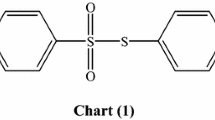Conclusions
-
1.
12, 15-Dihydro-12, 15-dioxo-13, 14-benzotrypticene (I) is polarographically and chemically reversibly reduced on a dropping mercury cathode in dimethylformamide medium and in a mixture of ethanol and toluene against a. background of 0.1 N LiCl.
-
2.
A difference in the mechanism of the reduction of the quinone (I) in the investigated media was demonstrated: in dimethylformamide the reduction proceeds through a stage of semiquinone formation (half-wave potentials equal to E1/2 I =−87 mV; E1/2 II =−472 mV); in an ethanol-toluene mixture, the reduction proceeds in one step (E1/2 =−502 mV). The constants of the diffusion current are equal to 2.62 and 3.04, respectively.
Similar content being viewed by others
Literature cited
E. I. Klabunovskii, L. V. Antik, and N. A. Ezerskaya, Izv. AN SSSR. Otd. Khim. N., No. 10, 1877 (1962).
W. Theilacker, U. Berger-Brose, and K. Beyer, Chem. Ber.93, 1658 (1960).
P. Zuman, Acta chim. Acad. scient, hung.18, No. 1, 141 (1959).
J. B. Conant and L. F. Fieser, J. Amer. Chem. Soc.46, 1859 (1924).
A. A. Balandin and E. I. Klabunovskii, Zh. Fiz. Khimii,33, 2480 (1959).
I. Ya. Postovskii and R. G. Beiles, Zh. Fiz. Khimii,20, 522 (1950).
F. L. Lambert, Analyt. Chem.39, 1018 (1958).
V. Gutmann and G. Schöber, Angew. Chemie.70, 98 (1958).
R. L. Edsberg and D. Eichlin, Analyt. Chem.25, 798 (1953).
S. Wawzonek, Analyt. Chem.30, 660 (1958).
C. Hurd and L. Juel, J. Amer. Chem. Soc.77, 601 (1955).
A. B. Thomas and E. G. Rochow, J. Amer. Chem. Soc.79, 1843 (1957).
P. H. Giren and M. E. Peover, J. Chem. Soc.1959, 1602.
W. R. Lewis, F. W. Quackenbush, and T. De Vries, Analyt. Chem.21, 762 (1949).
J. Bergman, Trans. Faraday Soc.50, 829 (1954).
R. Jones and T. M. Spotswood, Austral. J Chem.15, 492 (1962).
S. Wawzonek and R. Berkley, J. Elektrochem. Soc.102, 235 (1955);103, 456 (1956);108, 1135 (1961).
G. Markus, Science119, 324 (1954).
K. Schwabe, Der pH Messtechnik, Berlin (1958).
Author information
Authors and Affiliations
Additional information
Translated from Izvestiya Akademii Nauk SSSR, Setiya Khimicheskaya, No. 6, pp. 971–978, June, 1964
Rights and permissions
About this article
Cite this article
Klabunovskii, E.I., Antik, L.V. & Balandin, A.A. On the polarographic behavior of dihydrodioxobenzotrypticene. Russ Chem Bull 13, 908–913 (1964). https://doi.org/10.1007/BF01141640
Received:
Issue Date:
DOI: https://doi.org/10.1007/BF01141640




